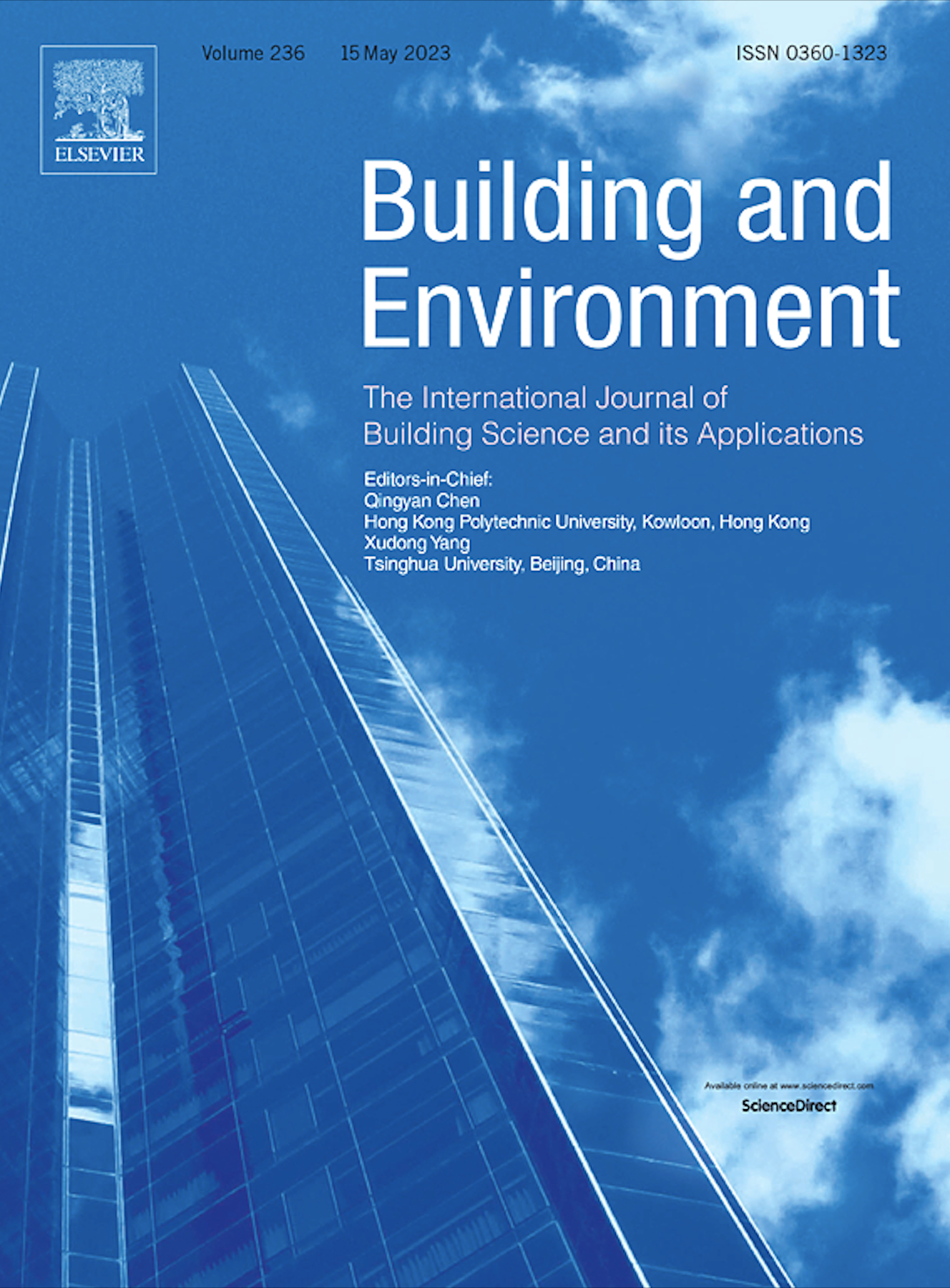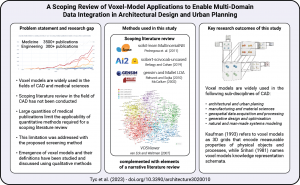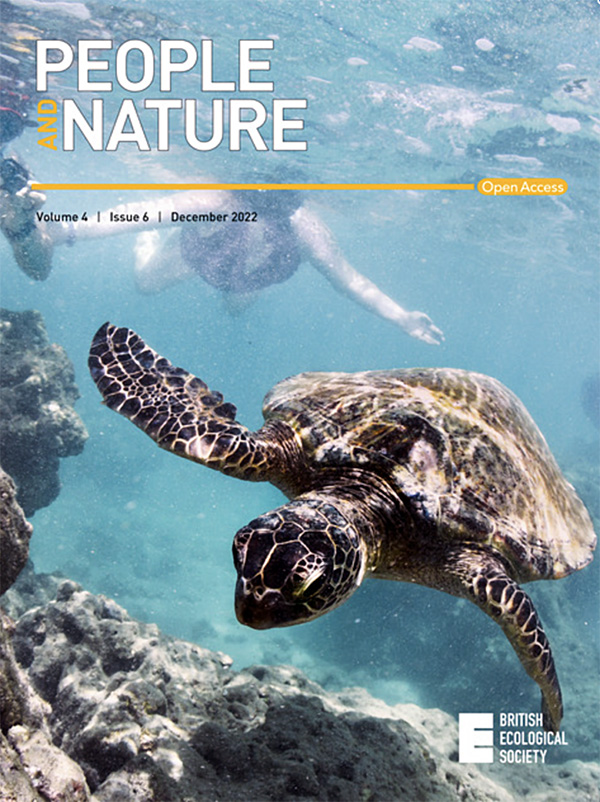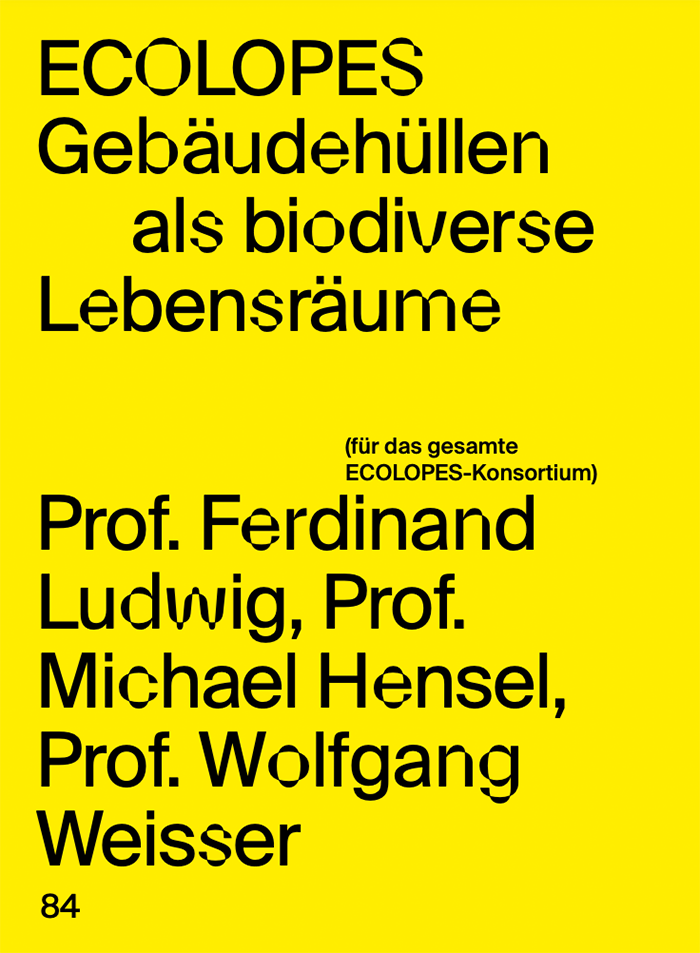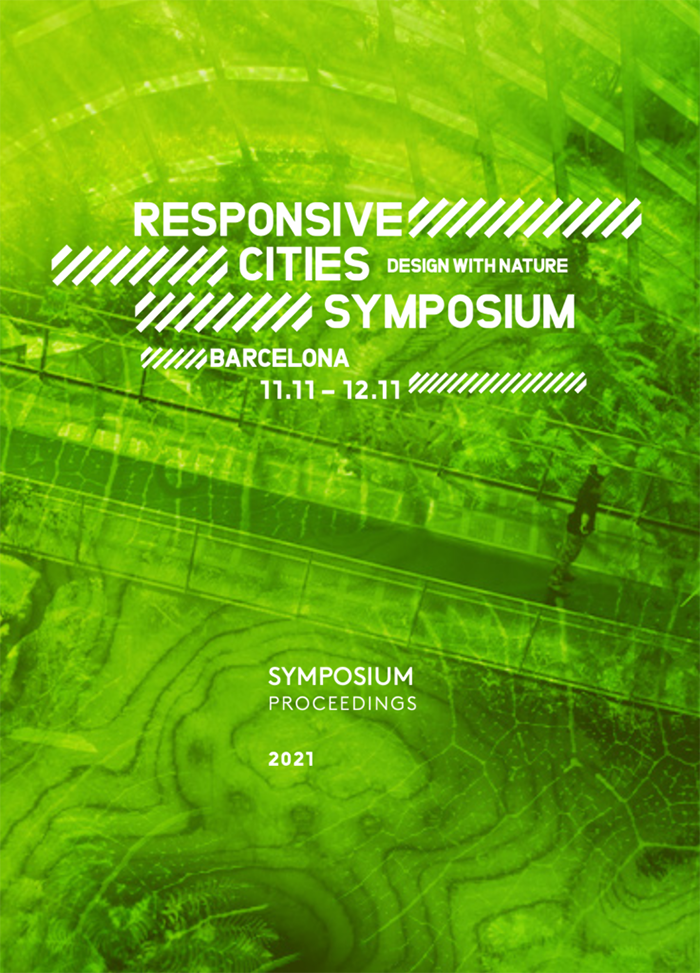PUBLICATIONS
ECOLOPES PUBLICATIONS
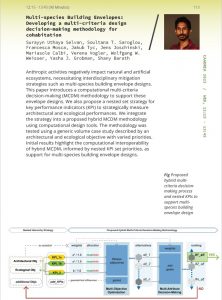
Selvan, S.U., Saroglou, S., T., Mosca, F., Tyc, J., Joschinksi, J., Calbi, M., Vogler, V., Weisser, W. W., Grobman, Y. J. & Barath, S. (2023) ‘Multi-species building envelopes: Developing a multi-criteria decision-making methodology for cohabitation’, in Proceedings of the 28th International Conference of the Association for Computer-aided Architectural Design Research in Asia. CAADRIA 2023, India. Available here
Selvan, S.U., Saroglou, S. T., Joschinksi, J., Calbi, M., Vogler, V., Barath, S. & Grobman, Y. J. (2023) ‘Toward multi-species building envelopes: A critical literature review of multi-criteria decision-making for design support’, Building and Environment, 231, p. 110006. Available at: https://doi.org/10.1016/j.buildenv.2023.110006
Tyc, Jakub & Selami, Tina & Sunguroglu Hensel, Defne & Hensel, Michael. (2023). A Scoping Review of Voxel-Model Applications to Enable Multi-Domain Data Integration in Architectural Design and Urban Planning. Architecture. 3. 137-174. 10.3390/architecture3020010.
Available online: https://besjournals.onlinelibrary.wiley.com
Wolfgang W. Weisser, Michael Hensel, Shany Barath, Victoria Culshaw, Yasha J. Grobman, Thomas E. Hauck, Jens Joschinski, Ferdinand Ludwig, Anne Mimet, Katia Perini, Enrica Roccotiello, Michael Schloter, Assaf Shwartz, Defne Sunguroğlu Hensel, Verena Vogler (07.12.2022.).
Creating ecologically sound buildings by integrating ecology, architecture and computational design.
Available online: https://besjournals.onlinelibrary.wiley.com
Ludwig, F., Hensel M. & Weisser, W.W. (2021).
ECOLOPES – Gebäudehüllen als biodiverse Lebensräume.
In: Bauen von morgen: Zukunftsthemen und Szenarien.
Bundesinstitut für Bau-, Stadt- und Raumforschung (BBSR) im Bundesamt für Bauwesen und Raumordnung (BBR).
Available online: https://www.bbsr.bund.de/BBSR/DE/veroeffentlichungen/sonderveroeffentlichungen
Perini, K., Barath, S., Canepa, M., Hensel, M., Mimet, A., Mosca, F., Roccotiello, E., Selami, T., Sunguroğlu Hensel, D., Tyc, J., Utahya Selvan S., Vogler V., Weisser W.W., (2021)
ECOLOPES - A multi-species design approach to building envelope design for regenerative urban ecosystems.
In: Responsive Cities: Design with Nature. Symposium Proceedings 2021 (IAAC).
Canepa, M., Mosca , F., Barath, S., Changenet, A., Hauck, T. E., Ludwig , F., Roccotiello, E., Pianta, M., Selvan, S. U., Vogler, V. and Perini , K. (2022)
Ecolopes, beyond greening. A multi-species approach for urban design
In: AGATHÓN | International Journal of Architecture, Art and Design, 11(online), pp. 238-245. doi: 10.19229/2464-9309/11212022.
PRE-ECOLOPES PUBLICATIONS
• Apfelbeck, B., Jakoby, C., Hanusch, M., Steffani, E.B., Hauck, T.E., & Weisser, W.W. (2019)
A conceptual framework for choosing target species for wildlife-inclusive urban design.
Sustainability 11 (24): 6972.
Available online: https://doi.org/10.3390/su11246972
• Apfelbeck, B., R. Snep, P. H., Hauck, T. E., Ferguson, J., Holy, M., Jakoby, C., Scott MacIvor, J., Schär, L., Taylor, M. & Weisser, W. W. (2020)
Designing wildlife-inclusive cities that support human-animal co-existence.
Landscape and Urban Planning 200: 103817.
Available online: https://doi.org/10.1016/j.landurbplan.2020.103817
• Eisenberg, B., C. Morandi, P. Richter, F. Well, M. Winker, R. Minke, H. Steinmetz & F. Ludwig (2021)
The Impulse Project Stuttgart—Stimulating Resilient Urban Development Through Blue-Green Infrastructure.
In: Building Resilience to Natural Hazards in the Context of Climate Change, Springer: 157-171.
Available online: https://link.springer.com/chapter/10.1007/978-3-658-33702-5_7#citeas
• Jakoby, C., Rogers, R., Apfelbeck, B., Hauck, T., & Weisser, W. W. (2019)
Wildtiere im Wohnumfeld: wie werden sie von Wohnungsunternehmen bewertet?
In: Natur und Landschaft 5: 181-187.
Available online: https://www.natur-und-landschaft.de/de/news/wildtiere-im-wohnumfeld-wie-werden-sie-von-wohnungsunternehmen-bewertet-1171
• Hensel M. (2012)
Modelling Modelling – Trajectories in Developing Instrumental Design Processes.
In: Ayres, P. (Ed.) Persistent Modelling: Extending the Role of Architectural Representation. London: Routledge, 71-80.
• Hensel, M. (2013)
Non-anthropocentric Architecture.
In: Hensel, M. (ed.) Performance-oriented Architecture – Rethinking Architectural Design and the Built Environment. Chichester: John Wiley & Sons, 45-52.
• Hensel M. (2019)
The Rights to Ground: Integrating Human and Non-Human Perspectives in an Inclusive Approach to Sustainability.
In: Sustainable Development 27: 245-251. doi: 10.1002/sd.1883
• Hensel, M. & Sunguroğlu Hensel, D. (2010)
Extended Thresholds II: The Articulated Threshold. Turkey: At the Threshold
In: AD Architectural Design 80(1): 20-25.
• Hensel, M., Sunguroğlu Hensel, D. & Sørensen, S.S. (2018)
Embedded Architectures: Inquiries into Architectures, Diffuse Heritage and Natural Environments in Search for better informed Design Approaches to Sustainability.
In: Time + Architecture 3 Vol. 161: 42-45.
• Hensel M. & Sunguroğlu Hensel D. (2020)
Embedded Architectures – An Overarching Approach to Compound Sustainability Problems including Urban Climate Mitigation.
In: A. Battisti & D. Santucci (Eds.) Activating Public Space – An Approach for Climate Change Mitigation. Munich: Technical University Munich, 55-63.
• Hensel M. & Sunguroğlu Hensel D. (2020)
Performances of Architectures and Environments – A Framework.
In: M. Kanaani (Ed.) The Routledge Companion to Performativity in Design and Architecture: Using Time to Craft an Enduring, Resilient and Relevant Architecture. Milton Park: Routledge, 1-17.
• Höpfl, L., D. Sunguroğlu Hensel, M. Hensel & F. Ludwig (2021).
Initiating Research into Adapting Rural Hedging Techniques, Hedge Types, and Hedgerow Networks as Novel Urban Green Systems.
In: Land 10(5): 529.
Available online: https://doi.org/10.3390/land10050529
• Ludwig, F. (2016)
Baubotanik: Designing with Living Material.
In: Löschke, S. (ed.) Materiality and Architecture. Routledge.
Available online: https://www.taylorfrancis.com/chapters/edit/10.4324/9781315732732-21/baubotanik-designing-living-material-ferdinand-ludwig
• Ludwig, F. (2021)
The Imposition of Uncertainty.
In: Urban Environments as Spaces of Living in Transformation, 21.
Available online: https://urbanenv.org/wp-content/uploads/2021/03/PDF-Collection-1.pdf#page=22
• Ludwig, F., W. Middleton, F. Gallenmüller, P. Rogers and T. Speck (2019).
Living bridges using aerial roots of ficus elastic – an interdisciplinary perspective.
In: Scientific reports 9(1): 1-11.
Available online: https://www.nature.com/articles/s41598-019-48652-w
• Ludwig, F. and D. Schönle (2018)
Growth as a Concept.
In: Hortitecture – The power of architecture and plants, Jovis: 65-71.
• Melsom, J., Fraguada, L., & Hurkxkens, I. (2017)
Onsite analysis: Developing a flexible software field-kit for landscape architecture and spatial design.
In: Journal of Digital Landscape Architecture 2: 262–270.
Available online: https://doi.org/10.14627/537629027
• Middleton, W., A. Habibi, S. Shankar & Ludwig, F. (2020).
Characterizing Regenerative Aspects of Living Root Bridges.
In: Sustainability 12(8): 3267.
Available online: https://doi.org/10.3390/su12083267
• Middleton, W., Shu, Q. & Ludwig, F. (2019)
Photogrammetry as a Tool for Living Architecture.
In: The International Archives of Photogrammetry, Remote Sensing and Spatial Information Sciences 42: 195-201.
Available online: https://pdfs.semanticscholar.org/d396/b7435db9b5df2fcef274919f9e469d9c2808.pdf
• Mimet, A., Kerbiriou, C., Simon, L., Julien, J. F. & Raymond, R. (2020)
Contribution of private gardens to habitat availability, connectivity and conservation of the common pipistrelle in Paris.
In: Landscape and Urban Planning 193.
Available online: https://doi.org/10.1016/j.landurbplan.2019.103671
• Perini, K., & Roccotiello, E. (2018)
Vertical greening systems for pollutants reduction.
In: Nature Based Strategies for Urban and Building Sustainability, Elsevier (imprint Butterworth-Heinemann): 131-140.
Available online: https://doi.org/10.1016/B978-0-12-812150-4.00012-4
• Perini, K., Castellari, P., Giachetta, A., Turcato, C., & Roccotiello, E. (2020)
Experiencing innovative biomaterials for buildings: Potentialities of mosses.
In: Building and Environment 172.
Available online: https://doi.org/10.1016/j.buildenv.2020.106708
• Perini, K., Chokhachian, A., Dong, S., & Auer, T. (2017), Modeling and simulating urban outdoor comfort: Coupling ENVI-Met and TRNSYS by grasshopper.
In: Energy and Buildings 152: 373-384.
Available online: https://doi.org/10.1016/j.enbuild.2017.07.061
• Perini, K., Ottelé, M., Giulini, S., Magliocco, A., & Roccotiello, E. (2017)
Quantification of fine dust deposition on different plant species in a vertical greening system.
In: Ecological Engineering 100:268-276.
Available online: https://doi.org/10.1016/j.ecoleng.2016.12.032
• Rosasco, P. & Perini, K. (2019)
Selection of (Green) Roof Systems: A Sustainability-Based Multi-Criteria Analysis.
In: Buildings 134: 1-17
Available online: https://doi.org/10.3390/buildings9050134
• Rosasco, P., & Perini, K. (2018)
Evaluating the economic sustainability of a vertical greening system: A Cost-Benefit Analysis of a pilot project in Mediterranean area.
In: Building and Environment 142: 524–533.
Available online: https://doi.org/10.1016/j.buildenv.2018.06.017
• Shu, Q., Middleton, W., Dörstelmann, M., Santucci, D. & Ludwig, F. (2020)
Urban Microclimate Canopy: Design, Manufacture, Installation, and Growth Simulation of a Living Architecture Prototype.
In: Sustainability 12(15): 6004.
Available online: https://doi.org/10.3390/su12156004
• Sunguroğlu Hensel, D. (2021)
Data-driven Design Research on Green Construction – Enabling Intensification and Restoration through Hybrid Typologies.
In: Dimensions – Journal of Architectural Knowledge.
• Sunguroğlu Hensel, D. (2020)
Ecological Prototypes – Initiating Design Innovation in Green Construction.
In: Sustainability 12 (14): 5865.
Available online: https://doi.org/10.3390/su12145865
• Sunguroğlu Hensel, D. & Vincent, J.F.V. (2015)
Evolutionary inventive problem-solving in biology and architecture: ArchiTRIZ and Material-Ontology.
In: Intelligent Buildings International 8 (2): 118-137.
Available online: https://doi.org/10.1080/17508975.2015.1014462
• Tyc J., Sunguroğlu Hensel D., Parisi E.I, Tucci G. & Hensel M. (2021)
Integration of remote sensing data into a composite voxel model for environmental performance analysis of terraced vineyards in Tuscany, Italy.
In: Remote Sensing 13(17): 3483. ISSN 2072-4292.
Available online: https://doi.org/10.3390/rs13173483
• Valkanova, N., Moghnieh, A., Arroyo, E., & Blat, J. (2010)
AmbientNEWS: Augmenting information discovery in complex settings through aesthetic design.
In: Proceedings of the International Conference on Information Visualisation, pp. 439–444.
Available online: https://doi.org/10.1109/IV.2010.67
• Vogler, V., Schneider S., Willmann J. (2019)
High-Resolution Underwater 3-d Monitoring Methods to Reconstruct Artificial Coral Reefs in the Bali Sea: A Case Study of an Artificial Reef Prototype in Gili Trawangan
In: Journal of Digital Landscape Architecture 4: 275–289.
Available online: https://doi.org/10.14627/537663030
• Vogler, V. (2022). A New Framework For Artificial Coral Reef Design. JoDLA Journal of Digital Landscape Architecture, Issue 7-2022, 524–537. Berlin/Offenbach: Wichmann Verlag im VDE VERLAG. e-ISSN 2511-624X. Available online: doi:10.14627/537724050https://gispoint.de/gisopen-paper/7348-a-new-framework-for-artificial-coral-reef-design.html?IDjournalTitle=6)
• Weisser, W. W., & Hauck, T. E. (2017)
ANIMAL-AIDED DESIGN – using a species’ life-cycle to improve open space planning and conservation in cities and elsewhere.
In: bioRxiv: 150359.
Available online: https://doi.org/10.1101/150359
• Well, F. & Ludwig, F. (2020).
Blue–green architecture: A case study analysis considering the synergetic effects of water and vegetation.
In: Frontiers of Architectural Research 9(1): 191-202.
Available online: https://doi.org/10.1016/j.foar.2019.11.001
• Well, F. & Ludwig, F. (2021).
Development of an Integrated Design Strategy for Blue-Green Architecture.
In: Sustainability 13(14): 7944.
Available online: https://doi.org/10.3390/su13147944

